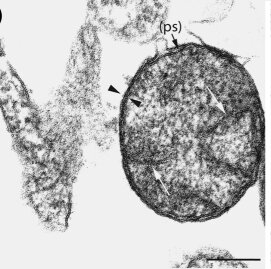Rickettsia helvetica
| Rickettsia helvetica | |
|---|---|
| Scientific classification | |
| Domain: | Bacteria |
| Phylum: | Pseudomonadota |
| Class: | Alphaproteobacteria |
| Order: | Rickettsiales |
| Family: | Rickettsiaceae |
| Genus: | Rickettsia |
| Species group: | Spotted fever group |
| Species: | R. helvetica
|
| Binomial name | |
| Rickettsia helvetica Beati, Peter, Burgdorfer, Aeschlirnami & Raoult, 1993[1]
| |
Rickettsia helvetica,[2] previously known as the Swiss agent, is a bacterium found in Dermacentor reticulatus and other ticks, which has been implicated as a suspected but unconfirmed human pathogen.[3][4][5] First recognized in 1979 in Ixodes ricinus ticks in Switzerland (hence the designation helvetica) as a new member of the spotted fever group of Rickettsia, the R. helvetica bacterium was eventually isolated in 1993.[6] Although R. helvetica was initially thought to be harmless in humans and many animal species, some individual case reports suggest that it may be capable of causing a nonspecific fever in humans.[4][5][7] In 1997, a man living in eastern France seroconverted to Rickettsia 4 weeks after onset of an unexplained febrile illness.[8] In 2010, a case report indicated that tick-borne R. helvetica can also cause meningitis in humans.[9]
Molecular evidence suggests that in Croatia, as many as 10% of D. reticulatus ticks are infected with R. helvetica.[10] In addition to this, R. slovaca[11] is found in another 2%, and 1% are infected with both species.[12]
Infection

Signs and symptoms
Erythema migrans or rash was observed at all combinations of seroreactivity, with symptoms including fever, muscle pain, headache, and respiratory problems.[13]
The spots (erythema migrans) are described as red spots, much lesser in size than those seen in Lyme disease, but sometimes no spots occur at all.[14]
Treatment
As with other rickettsioses, the treatment of choice is doxycycline[15]
Epidemiology
In 80 healthy Swedish blood donors, about 1% were seroreactive for Rickettsia spp., interpreted as past infection. In a prospective study of Swedish recruits who trained in the coastal areas, 8.9% showed seroconversion[13]
See also
References
- ↑ Xue-Jie Yu & David H. Walker (2005). "Genus I. Rickettsia da Rocha Lima 1916, 567". In Don J. Brenner; Noel R. Krieg; George M. Garrity & James T. Staley (eds.). The proteobacteria, Part 3. Bergey's Manual of Systematic Bacteriology. Vol. 2 (2 ed.). Springer. pp. 96–114. ISBN 978-0-387-24145-6.
- ↑ "Rickettsia helvetica". Archived from the original on 2015-09-06. Retrieved 2023-01-17.
- ↑ Piller, Charles (October 12, 2016). "The 'Swiss Agent': Long-forgotten research unearths new mystery about Lyme disease". Archived from the original on November 21, 2016. Retrieved December 19, 2016.
- ↑ 4.0 4.1 Parola, P.; Davoust, B.; Raoult, D. (2005). "Tick- and flea-borne rickettsial emerging zoonoses" (PDF). Veterinary Research. 36 (3): 469–492. doi:10.1051/vetres:2005004. PMID 15845235. Archived (PDF) from the original on 2019-05-04. Retrieved 2023-01-17.
- ↑ 5.0 5.1 Walker, D. H. (2007). "Rickettsiae and Rickettsial Infections: The Current State of Knowledge". Clinical Infectious Diseases. 45: S39–S44. doi:10.1086/518145. PMID 17582568.
- ↑ Beati, L.; Péter, O.; Burgdorfer, W.; Aeschlimann, A.; Raoult, D. (1993). "Confirmation that Rickettsia helvetica sp. nov. Is a distinct species of the spotted fever group of rickettsiae". International Journal of Systematic Bacteriology. 43 (3): 521–526. doi:10.1099/00207713-43-3-521. PMID 8102245.
- ↑ Dobler, G.; Wölfel, R. (2009). "Typhus and other rickettsioses: Emerging infections in Germany". Deutsches Ärzteblatt International. 106 (20): 348–354. doi:10.3238/arztebl.2009.0348. PMC 2689634. PMID 19547738.
- ↑ Fournier, P. E.; Grunnenberger, F.; Jaulhac, B.; Gastinger, G.; Raoult, D. (2000). "Evidence of Rickettsia helvetica infection in humans, eastern France". Emerging Infectious Diseases. 6 (4): 389–392. doi:10.3201/eid0604.000412. PMC 2640907. PMID 10905974.
- ↑ Nilsson, K.; Elfving, K.; Pahlson, C. (2010). "Rickettsia helvetica in Patient with Meningitis, Sweden, 2006". Emerging Infectious Diseases. 16 (3): 490–492. doi:10.3201/eid1603.090184. PMC 3322002. PMID 20202426.
- ↑ Dobec, M.; Golubic, D.; Punda-Polic, V.; Kaeppeli, F.; Sievers, M. (2009). "Rickettsia helvetica in Dermacentor reticulatus ticks". Emerging Infectious Diseases. 15 (1): 98–100. doi:10.3201/eid1501.080815. PMC 2660705. PMID 19116063.
- ↑ "Rickettsia slovaca". Archived from the original on 2021-12-05. Retrieved 2023-01-17.
- ↑ "Rickettsia helvetica in Ticks | CDC EID". Cdc.gov. 2008-12-23. Archived from the original on 2009-11-05. Retrieved 2011-08-13.
- ↑ 13.0 13.1 Lindblom, A.; Wallménius, K.; Nordberg, M.; Forsberg, P.; Eliasson, I.; Påhlson, C.; Nilsson, K. (2012). "Seroreactivity for spotted fever rickettsiae and co-infections with other tick-borne agents among habitants (sic) in central and southern Sweden". European Journal of Clinical Microbiology & Infectious Diseases. 32 (3): 317–323. doi:10.1007/s10096-012-1742-3. PMC 3569577. PMID 22961007.
- ↑ "Fästingar sprider fläcktyfus". Archived from the original on 2016-03-04. Retrieved 2023-01-17.
- ↑ Botelho-Nevers E, Socolovschi C, Raoult D, Parola P. Treatment of Rickettsia spp. infections: a review. Archived 2013-02-21 at the Wayback Machine Expert Rev Anti Infect Ther 2012; 10:1425–1437